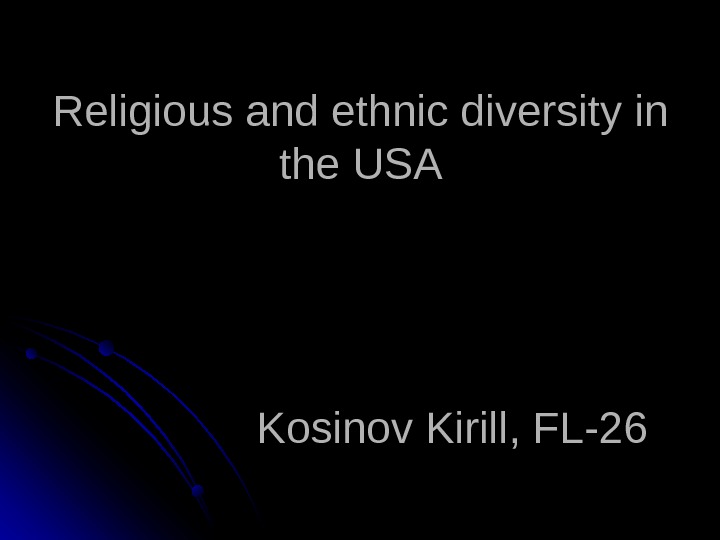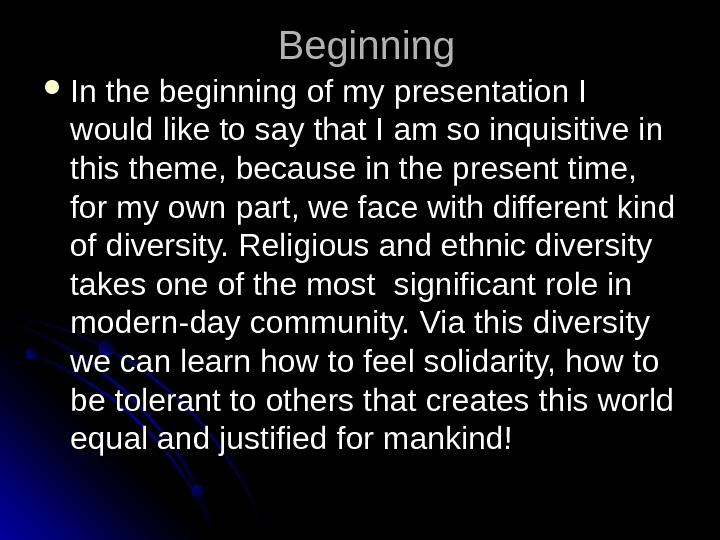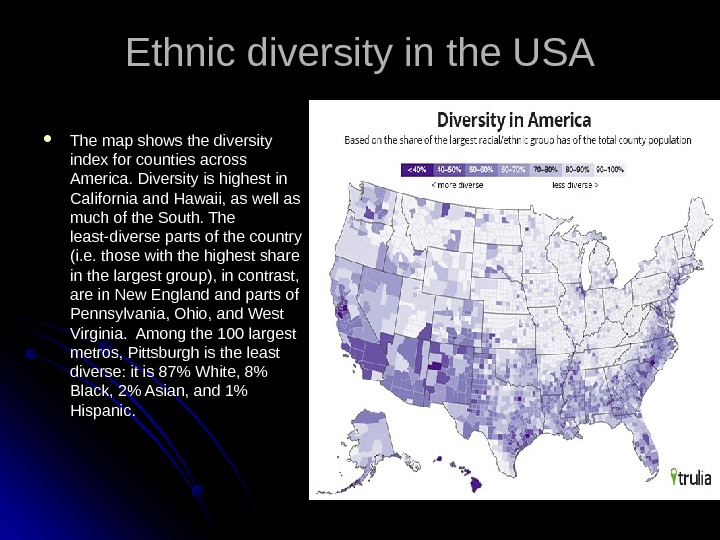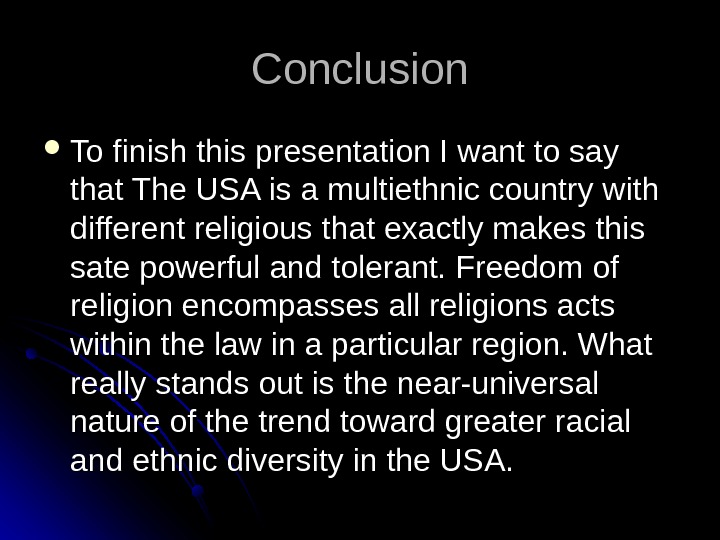Religious and ethnic diversity in the USA











religious_and_ethnic_diversity_in_the_usa.ppt
- Размер: 898.5 Кб
- Количество слайдов: 10
Описание презентации Religious and ethnic diversity in the USA по слайдам
 Religious and ethnic diversity in the USA Kosinov Kirill, FL-
Religious and ethnic diversity in the USA Kosinov Kirill, FL-
 In the beginning of my presentation I would like to say that I am so inquisitive in this theme, because in the present time, for my own part, we face with different kind of diversity. Religious and ethnic diversity takes one of the most significant role in modern-day community. Via this diversity we can learn how to feel solidarity, how to be tolerant to others that creates this world equal and justified for mankind! Beginning
In the beginning of my presentation I would like to say that I am so inquisitive in this theme, because in the present time, for my own part, we face with different kind of diversity. Religious and ethnic diversity takes one of the most significant role in modern-day community. Via this diversity we can learn how to feel solidarity, how to be tolerant to others that creates this world equal and justified for mankind! Beginning
 Now I want to examine the religions in the USA Religion in the United States is characterized by both a wide diversity in religious beliefs and practices and by a high adherence level Religious symbols represented in this picture reflect the religious diversity in the United States. Among the symbols one can recognize Islam, Judaism, Christianity, and Buddhism. According to the U. S. Census, the most common religions in the United States are Christianity, Judaism, Islam, Buddhism, Hinduism, and unaffiliated religions, including atheists or agnostics. Religious diversity in the US
Now I want to examine the religions in the USA Religion in the United States is characterized by both a wide diversity in religious beliefs and practices and by a high adherence level Religious symbols represented in this picture reflect the religious diversity in the United States. Among the symbols one can recognize Islam, Judaism, Christianity, and Buddhism. According to the U. S. Census, the most common religions in the United States are Christianity, Judaism, Islam, Buddhism, Hinduism, and unaffiliated religions, including atheists or agnostics. Religious diversity in the US
 Religious diversity in the USA I had read in the internet source that majority of Americans report that religion plays a «very important» role in their lives( I mentioned this idea when had started my presentation), a proportion unique among developed nations. Many faiths have flourished in the United States, including those spanning the country’s multicultural immigrant heritage, as well as those founded within the country; these have led the United States to become one of the most religiously diverse countries in the world. Crystal Cathedral, a former Protestant mega church in California Sikh Center of San Francisco Bay Area
Religious diversity in the USA I had read in the internet source that majority of Americans report that religion plays a «very important» role in their lives( I mentioned this idea when had started my presentation), a proportion unique among developed nations. Many faiths have flourished in the United States, including those spanning the country’s multicultural immigrant heritage, as well as those founded within the country; these have led the United States to become one of the most religiously diverse countries in the world. Crystal Cathedral, a former Protestant mega church in California Sikh Center of San Francisco Bay Area
 Religious diversity in the USA The largest religion in the United States is Christianity, practiced by the majority of the population. Due to its large population and history, the United States has numerically more Christians (and more Protestants) than any other country in the world. After Christianity and no-religion, Judaism is the third-largest religious affiliation in the United States, though this identification is not necessarily indicative of religious beliefs or practices. A significant number of people identify themselves as American Jews on ethnic and cultural grounds, rather than religious ones. On the other hand, American Islam effectively began with the arrival of African slaves. It is estimated that about 10% of African slaves transported to the United States were Muslim. Research indicates that Muslims in the United States are generally more assimilated and prosperous than Muslims in Europe.
Religious diversity in the USA The largest religion in the United States is Christianity, practiced by the majority of the population. Due to its large population and history, the United States has numerically more Christians (and more Protestants) than any other country in the world. After Christianity and no-religion, Judaism is the third-largest religious affiliation in the United States, though this identification is not necessarily indicative of religious beliefs or practices. A significant number of people identify themselves as American Jews on ethnic and cultural grounds, rather than religious ones. On the other hand, American Islam effectively began with the arrival of African slaves. It is estimated that about 10% of African slaves transported to the United States were Muslim. Research indicates that Muslims in the United States are generally more assimilated and prosperous than Muslims in Europe.
 Ethnic diversity in the USA The map shows the diversity index for counties across America. Diversity is highest in California and Hawaii, as well as much of the South. The least-diverse parts of the country (i. e. those with the highest share in the largest group), in contrast, are in New England and parts of Pennsylvania, Ohio, and West Virginia. Among the 100 largest metros, Pittsburgh is the least diverse: it is 87% White, 8% Black, 2% Asian, and 1% Hispanic.
Ethnic diversity in the USA The map shows the diversity index for counties across America. Diversity is highest in California and Hawaii, as well as much of the South. The least-diverse parts of the country (i. e. those with the highest share in the largest group), in contrast, are in New England and parts of Pennsylvania, Ohio, and West Virginia. Among the 100 largest metros, Pittsburgh is the least diverse: it is 87% White, 8% Black, 2% Asian, and 1% Hispanic.
 Ethnic diversity in the USA Ethnic groups: white 79. 96%; black 12. 85%; Asian 4. 43%; Amerindian and Alaska native 0. 97%; native Hawaiian and other Pacific islander 0. 18%; two or more races 1. 61% (July 2007 estimate)
Ethnic diversity in the USA Ethnic groups: white 79. 96%; black 12. 85%; Asian 4. 43%; Amerindian and Alaska native 0. 97%; native Hawaiian and other Pacific islander 0. 18%; two or more races 1. 61% (July 2007 estimate)
 Conclusion To finish this presentation I want to say that The USA is a multiethnic country with different religious that exactly makes this sate powerful and tolerant. Freedom of religion encompasses all religions acts within the law in a particular region. What really stands out is the near-universal nature of the trend toward greater racial and ethnic diversity in the USA.
Conclusion To finish this presentation I want to say that The USA is a multiethnic country with different religious that exactly makes this sate powerful and tolerant. Freedom of religion encompasses all religions acts within the law in a particular region. What really stands out is the near-universal nature of the trend toward greater racial and ethnic diversity in the USA.



